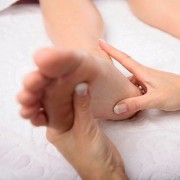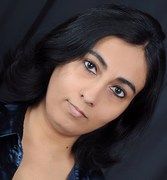 Photo: Getty Images
Photo: Getty Images
As much as back pain is a common complaint at physiotherapy centers across the globe (most people suffer from upper back pain at least once in their lifetimes), it does not make it any less painful, hard to tackle and long lasting. Medically, it is referred to as thoracic pain.
Though the upper spine is strong enough to support the weight of our upper bodies along with all the organs in our ribcage, the pain can occur anywhere between the nape of the neck to the top of the lumbar spine due to a variety of reasons, such as a viral cold, bad posture, using the wrong form while exercising, sciatica, endometriosis, kidney stones, shingles, fibromyalgia, bone cancer, fracture, osteoarthritis, pancreatic cancer, dissection of the aorta, spinal infection, muscle spasm, pregnancy, etc. Do check the cause with your general physician before you begin your reflexology program.
In reflexology, aches involving the area around shoulder, shoulder blades and pain of the trapezius and rhomboideus major and minor can occur with imbalances in the meridians: the small intestine meridian, the large intestine meridian, the bladder meridian, the gall bladder meridian and the triple burner/endocrine meridian. These meridians will be attended to during the reflexology therapy for upper back pain.
CAUTIONS AND NOTES DURING UPPER BACK PAIN REFLEXOLOGY THERAPY:
• The patient should drink plenty of water through the day and post-therapy sessions.
• The patient should avoid weight-bearing exercises in the duration (couple of weeks) of the therapy.
• It takes at least three to four therapy sessions before a patient begins to note any improvement in his/her condition.
• Upper back pain is also synonymous with stress and tension, so the patient is advised deep breathing exercises as an aid to reflexology therapy.
• The patient should report any discomfort within the next 24 hours
• Diet should be assessed for the amount of calcium, phosphorus and vitamin E in a day.
• If pain recurs between therapy sessions, an ice pack and/or topical application such as any anti-inflammatory and analgesic oil, gel suitable for the skin may be applied.
BEGINNING WITH RELAXATION TECHNIQUE:
1. The therapy should begin with a relaxation foot massage which will give the time to help establish a patient-therapist rapport and ease the patient’s general mental and physical stress.
2. The patient’s left foot is held with both the hands and with the therapist’s fingers on top of the patient’s foot and the thumb at the base/ balls of their foot.
3. The therapist may want to use warm eucalyptus oil to stimulate and uplift the client but needs to ask if the patient is not allergic to its sharp aroma. Being less viscous it would help in easy gliding, hooking, etc.
4. Next the therapist sets out with loosening the left foot with a back and forth movement of the foot.
5. Now, the therapist performs toe rotation for each toe of the left foot. First the rotations were clockwise and then followed by anti-clockwise rotations.
6. Then, a sliding and rotating technique may be followed where the therapist slides their right and then left thumb from the center of the patient’s foot up to the outer edge of the toe.
7. Lastly, for relaxation, an ankle rotation technique is executed, where the therapist holds the patient’s foot at the base of the big toe with the left hand and the hand used for holding the ankle is used as a pivot rotated the foot gently with my left hand in a 360 degree circle.
8. Having finished with the left foot, the right foot is taken up to replicate Step 4-7.
TREATMENT:
1. The reflexologist will begin with the patient’s left foot again with a slow thumb-walk technique along the entire spine, neck and head landmark on his foot (the straight line running along the inner arch of the foot).
2. Stops are made for the press and roll technique in places that corresponded with the base of the skull (the base of the big toe), the neck (area parallel and just below the base of the big toe) and the shoulders (are enclosed by a semi-circular arch at the outer side of the of the foot, half an inch below the little toe).
3. Steps 1 and 2 are replicated on the right foot.
4. Back to the left foot, the therapist will be knuckling the base of whole foot.
5. Next, the reflexolgist uses the hook technique on the location of the sternum and shoulder girdle both the sides of the left foot for 30 seconds each alternating between them – sternum dorsal side of foot, sternum base of the foot, and shoulder girdle on dorsal then base of the foot. Then replicate it for the for the right foot.
6. The reflexologist, at this point, will take into account areas on the foot that corresponded to the small intestine, large intestine, bladder, gall bladder and the endocrine systems.
7. The therapist can use a pressing and rolling technique for the area that corresponds to the small intestine first on the left foot. The location for the small intestine reflex on the foot is approximately midway in heel of the foot, towards the inner arch side, about half an inch from the edge.
8. Next the area which is the reflex of the large intestine is handled. This is in the same horizontally straight line from the point of small intestine, half an inch from the outer edge of the foot.
9. Then the gall bladder reflex is tackled with a hook and roll technique. This meridian is located approximately at the middle of the base of the foot, just above the waist level zone division.
10. After this a basic thumb technique to the bladder reflex is given - an inch and quarter directly below the small intestine reflex.
11. Next up is the endocrine reflexes on which the hook technique is used and the same is employed on each on the reflexes of the pitutary, thyroid, parathyroid, pancreas, and adrenalin glands.
12. The therapy usually ends with another relaxation massage of the patient’s whole left and right foot and at the end the feet is wiped with moist wool to remove any excess eucalyptus oil from them.
*Benefits, side-effects, prior preparations, costs, duration of procedure, recovery and resumption of daily activities as well as support issues should be discussed with your therapist for each type of option before starting on your program.
Mamta Singh is a published author of the books Migraines for the Informed Woman (Publisher: Rupa & Co.), the upcoming Mentor Your Mind (Publisher: Sterling Publishers) and An Urban Woman's Integrated Fitness Guide (Publishers: Hay House). She is also a seasoned business, creative and academic writer. She is a certified fitness instructor, personal trainer & sports nutritionist through IFA, Florida USA. Mamta is an NCFE-certified Holistic Health Therapist SAC Dip U.K. She is the lead writer and holds Expert Author status in many well-received health, fitness and nutrition sites. She runs her own popular blogs on migraines in women and holistic health. Mamta holds a double Master's Degree in Commerce and Business. She is a registered practitioner with the UN recognised Art of Living Foundation. Link: http://www.migrainingjenny.wordpress.com. Visit www.mamtasingh.com





Add a CommentComments
There are no comments yet. Be the first one and get the conversation started!